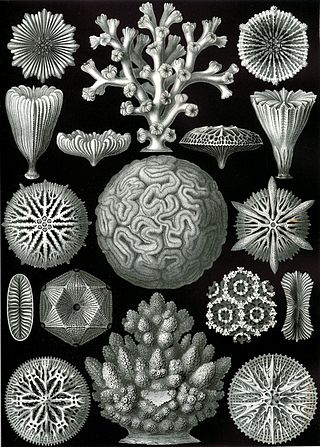
Scleractinia, also called stony corals or hard corals, are marine animals in the phylum Cnidaria that build themselves a hard skeleton. The individual animals are known as polyps and have a cylindrical body crowned by an oral disc in which a mouth is fringed with tentacles. Although some species are solitary, most are colonial. The founding polyp settles and starts to secrete calcium carbonate to protect its soft body. Solitary corals can be as much as 25 cm (10 in) across but in colonial species the polyps are usually only a few millimetres in diameter. These polyps reproduce asexually by budding, but remain attached to each other, forming a multi-polyp colony of clones with a common skeleton, which may be up to several metres in diameter or height according to species.

Mussidae is a family of stony coral in the order Scleractinia. Following a taxonomic revision in 2012, the family is now restricted to species found in the Atlantic Ocean, with Pacific species transferred to the new family Lobophylliidae. Many species are referred to as brain coral because their generally spheroid form and grooved surface resembles the convolutions of a brain.

The Fungiidae are a family of Cnidaria, commonly known as mushroom corals or plate corals. The family contains thirteen extant genera. They range from solitary corals to colonial species. Some genera such as Cycloseris and Fungia are solitary organisms, Polyphyllia consists of a single organism with multiple mouths, and Ctenactis and Herpolitha might be considered as solitary organisms with multiple mouths or a colony of individuals, each with its separate mouth.
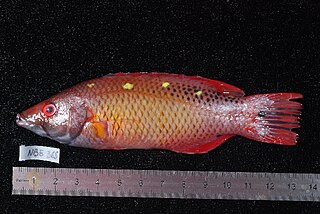
Diana's hogfish, Bodianus diana, is a species of wrasse native to the Indian Ocean from the African coast to the Nicobars and the Cocos-Keeling Islands. Reports of its presence in the western Pacific Ocean are erroneous. It occurs on the seaward side of reefs at depths from 6 to 50 m. It can reach a length of 16.9 cm (6.7 in). This species is of minor importance to local commercial fisheries and is found in the aquarium trade.
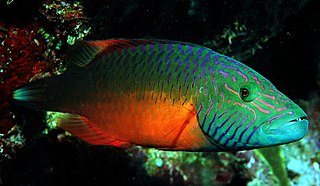
The cheek-lined wrasse, Oxycheilinus digramma, is a species of wrasse native to the Indian Ocean and the western Pacific Ocean. It is of minor importance to local commercial fisheries and can also be found in the aquarium trade. The fish grows to about 40 cm (16 in) in standard length. The side of the fish's head has horizontal stripes, while the front of the head has red spots. Coloring of the fish varies from pale gray to purple. Aquarium specimens are less tense than their wild counterparts.
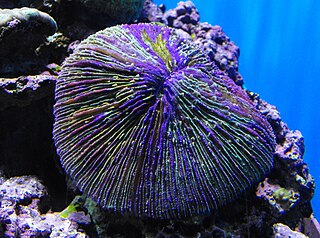
Fungia is a genus of corals in the family Fungiidae. It is monotypic with the single species Fungia fungites, which is found growing on reefs in the Indo-Pacific.

Cycloseris is a genus of solitary disc corals in the family Fungiidae. They are found in the Indo-Pacific. They inhabit the lower reef slopes, and the areas between reefs with soft sediments. They tolerate turbid waters.

Lobactis is a genus of plate or mushroom coral in the family Fungiidae. The genus is monotypic with a single species, Lobactis scutaria, that is found in the Indo-Pacific region.
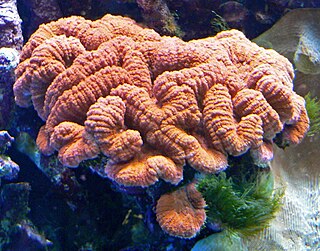
Lobophyllia hemprichii, commonly called lobed brain coral, lobed cactus coral or largebrain root coral, is a species of large polyp stony coral in the family Lobophylliidae. It is found in the Indo-Pacific Ocean. In its specific name Christian Gottfried Ehrenberg honoured his late partner the Prussian naturalist Wilhelm Hemprich; they were among the first to study the marine life of the Red Sea.
Alveopora fenestrata is a species of stony coral that is found in the Red Sea, the Gulf of Aden, the southwest and northern Indian Ocean, the central Indo-Pacific, Australia, Southeast Asia and the oceanic west Pacific Ocean. It can be found in shallow coral reefs, to a depth of 30 metres (100 ft). It is particularly susceptible to coral bleaching.

Alveopora spongiosa is a species of stony coral that is found in the Red Sea, the Gulf of Aden, the southwest and northern Indian Ocean, the central Indo-Pacific, Australia, Southeast Asia Japan, the East China Sea and the oceanic west and central Pacific Ocean. It can be found on protected upper coral reef slopes, generally from depth of 9–20 m, but can grow at depths of up to 50 m. It is moderately susceptible to coral bleaching, and is harvested for the aquarium trade.
Alveopora verrilliana is a species of stony coral that is found in the Red Sea, the Gulf of Aden, the northern Indian Ocean, the central Indo-Pacific, Australia, Southeast Asia, Japan, the East China Sea, the oceanic west and central Pacific Ocean and the Johnston Atoll. It can also be found in Palau and the southern Mariana Islands. It grows on shallow coral reefs to a depth of 30 metres (100 ft). It is particularly susceptible to coral bleaching and is harvested for the aquarium trade.
Alveopora viridis is a species of stony coral that has a highly disjunct range, and can be found in the Red Sea, the Gulf of Aden, the northern Indian Ocean and in Palau and the Mariana Islands. It is found on lower coral reef slopes to depths of 50 m. It is particularly susceptible to coral bleaching and is harvested for the aquarium trade.

Turbinaria is a genus of colonial stony corals in the family Dendrophylliidae. Common names for this genus include disc coral, scroll coral, cup coral, vase coral, pagoda coral and ruffled ridge coral. These corals are native to the Red Sea, Indian Ocean, Japan and the south Central Pacific Ocean.

Turbinaria peltata, commonly known as disc coral, is a species of colonial stony coral in the family Dendrophylliidae. It is native to the Indo-Pacific region. The International Union for Conservation of Nature has rated its conservation status as being "vulnerable".

Favites pentagona is a species of stony coral in the family Merulinidae, sometimes known as larger star coral. It is native to the Indo-Pacific region and its range extends from the Red Sea through the Indian Ocean to the Western Pacific Ocean. This is a common species throughout its wide range and the International Union for Conservation of Nature has rated its conservation status as being of "least concern".

Herpolitha is a monotypic genus of mushroom corals in the family Fungiidae. The only member of the genus is Herpolitha limax, commonly known as the tongue, slipper, mole or striate boomerang coral. It is a free-living species and is native to reefs and lagoons in the Indo-Pacific region. The International Union for Conservation of Nature has assessed this coral as being of "least concern".

Blastomussa merleti, commonly known as pineapple coral, is a species of large polyp stony coral. It is unclear in which family the genus Blastomussa belongs. This coral is native to the west and central Indo-Pacific region and is sometimes used in reef aquaria.
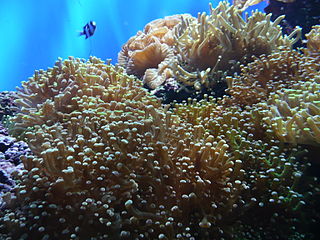
Euphylliidae are known as a family of polyped stony corals under the order Scleractinia.

Cycloseris distorta is a species of disc coral in the family Fungiidae. It is a free-living, solitary coral and is native to the tropical and subtropical Indo-Pacific region where it is found on soft sediment in shallow water.


















